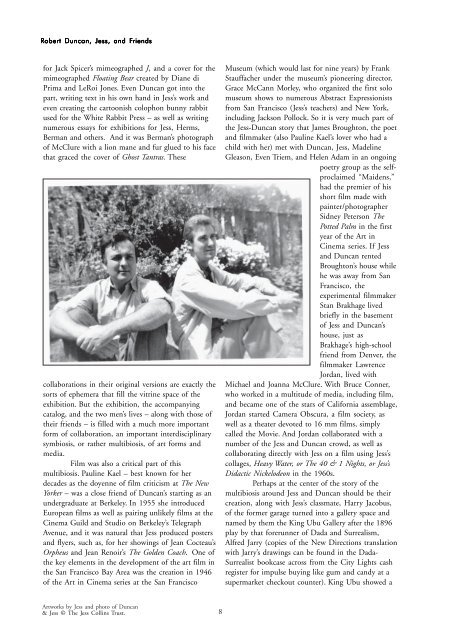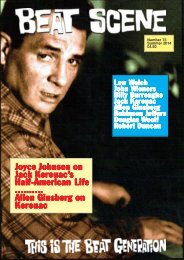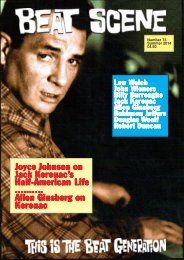You also want an ePaper? Increase the reach of your titles
YUMPU automatically turns print PDFs into web optimized ePapers that Google loves.
Robert Duncan, Jess, and Friends<br />
for Jack Spicer’s mimeographed J, and a cover for the<br />
mimeographed Floating Bear created by Diane di<br />
Prima and LeRoi Jones. Even Duncan got into the<br />
part, writing text in his own hand in Jess’s work and<br />
even creating the cartoonish colophon bunny rabbit<br />
used for the White Rabbit Press – as well as writing<br />
numerous essays for exhibitions for Jess, Herms,<br />
Berman and others. And it was Berman’s photograph<br />
of McClure with a lion mane and fur glued to his face<br />
that graced the cover of Ghost Tantras. These<br />
collaborations in their original versions are exactly the<br />
sorts of ephemera that fill the vitrine space of the<br />
exhibition. But the exhibition, the accompanying<br />
catalog, and the two men’s lives – along with those of<br />
their friends – is filled with a much more important<br />
form of collaboration, an important interdisciplinary<br />
symbiosis, or rather multibiosis, of art forms and<br />
media.<br />
Film was also a critical part of this<br />
multibiosis. Pauline Kael – best known for her<br />
decades as the doyenne of film criticism at The New<br />
Yorker – was a close friend of Duncan’s starting as an<br />
undergraduate at Berkeley. In 1955 she introduced<br />
European films as well as pairing unlikely films at the<br />
Cinema Guild and Studio on Berkeley’s Telegraph<br />
Avenue, and it was natural that Jess produced posters<br />
and flyers, such as, for her showings of Jean Cocteau’s<br />
Orpheus and Jean Renoir’s The Golden Coach. One of<br />
the key elements in the development of the art film in<br />
the San Francisco Bay Area was the creation in 1946<br />
of the Art in Cinema series at the San Francisco<br />
Museum (which would last for nine years) by Frank<br />
Stauffacher under the museum’s pioneering director,<br />
Grace McCann Morley, who organized the first solo<br />
museum shows to numerous Abstract Expressionists<br />
from San Francisco (Jess’s teachers) and New York,<br />
including Jackson Pollock. So it is very much part of<br />
the Jess-Duncan story that James Broughton, the poet<br />
and filmmaker (also Pauline Kael’s lover who had a<br />
child with her) met with Duncan, Jess, Madeline<br />
Gleason, Even Triem, and Helen Adam in an ongoing<br />
poetry group as the selfproclaimed<br />
“Maidens,”<br />
had the premier of his<br />
short film made with<br />
painter/photographer<br />
Sidney Peterson The<br />
Potted Palm in the first<br />
year of the Art in<br />
Cinema series. If Jess<br />
and Duncan rented<br />
Broughton’s house while<br />
he was away from San<br />
Francisco, the<br />
experimental filmmaker<br />
Stan Brakhage lived<br />
briefly in the basement<br />
of Jess and Duncan’s<br />
house, just as<br />
Brakhage’s high-school<br />
friend from Denver, the<br />
filmmaker Lawrence<br />
Jordan, lived with<br />
Michael and Joanna McClure. With Bruce Conner,<br />
who worked in a multitude of media, including film,<br />
and became one of the stars of California assemblage,<br />
Jordan started Camera Obscura, a film society, as<br />
well as a theater devoted to 16 mm films, simply<br />
called the Movie. And Jordan collaborated with a<br />
number of the Jess and Duncan crowd, as well as<br />
collaborating directly with Jess on a film using Jess’s<br />
collages, Heavy Water, or The 40 & 1 Nights, or Jess’s<br />
Didactic Nickelodeon in the 1960s.<br />
Perhaps at the center of the story of the<br />
multibiosis around Jess and Duncan should be their<br />
creation, along with Jess’s classmate, Harry Jacobus,<br />
of the former garage turned into a gallery space and<br />
named by them the King Ubu Gallery after the 1896<br />
play by that forerunner of Dada and Surrealism,<br />
Alfred Jarry (copies of the New Directions translation<br />
with Jarry’s drawings can be found in the Dada-<br />
Surrealist bookcase across from the City Lights cash<br />
register for impulse buying like gum and candy at a<br />
supermarket checkout counter). King Ubu showed a<br />
Artworks by Jess and photo of Duncan<br />
& Jess © The Jess Collins Trust.<br />
8





